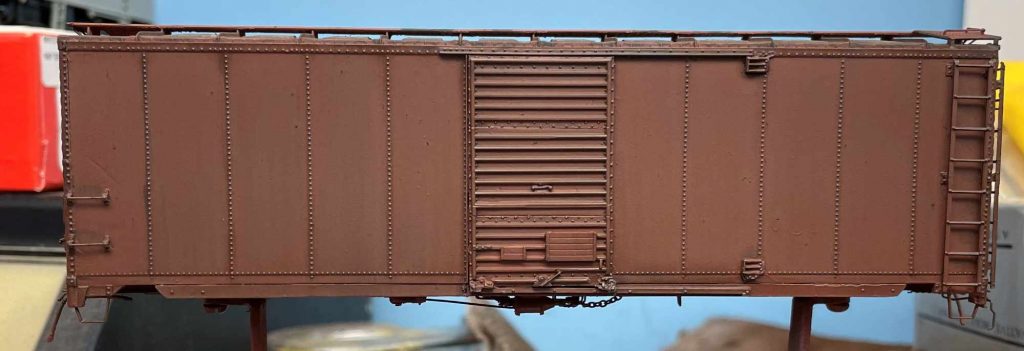
Here’s the fifth and final installment for the Missouri Pacific box car group kit build. Jerry Hamsmith summarizes the steps of getting these models ready to operate on our layouts.
During the 1940s, the typical Missouri Pacific (MP) freight car color was box car red. However, this shade of red had a slightly brown hue.
MP’s practice was to paint the box car roofs and running boards the same color as the sides and ends. Any type of paint available in the early 1940s would not adhere well to galvanized steel surfaces. The roof sheets and running boards were fabricated from galvanized steel. The paint would adhere much better to the seam caps, as they were made of open-hearth steel. These details can be seen in the lead photo, a classic scene photographed by Jack Delano in 1943.
The trucks and car underframes were painted black. When new, the tack and route boards were also painted black. After delivery in April and May 1942, it wouldn’t have taken long for the paint on the roof sheets and the running boards to begin peeling away. Anyone modeling these box cars around 1945 to 1947 and later in original paint should model the paint failure. There should be blotchy spots on the roof panels. They might be entirely void of paint except for the seam caps that retained the paint.
Repainted cars after June 1949 would have received the Route of the Eagles slogans and the larger 42-inch diameter buzz-saw emblem. Any box car red applied to the roof of a repainted car would not have lasted very long on the roof sheets as the cycle was repeated.
Initial coat
Using currently available Tru-Color Paint, their TCP-139 (MP Boxcar Red) is a close match. Recognizing that any car that is not new will have a different shade than one off the assembly line, changes can be made to that color.
Our group took varying approaches to the painting of the car. Ed Rethwisch and I used the TCP paint.
Chris Vanko also used the TCP paint, but Chris “pre-weathered” his car with oils that changed the color. Chris and I applied Tamiya Fine Gray Surface Primer out of a rattle can before spraying the car color. Tru-Color Paint does not adhere well to resin. A primer coat is highly recommended.
Lettering
Allen DeBraal used Modelers Decals and Paint Box Car Red, which is said to be a duplicate of the Floquil Boxcar Red.
Allen had decaled his model before snapping a picture after it was painted. He had not weathered it yet. Allen, who models the early 1950s, used the kit provided I-GN decals for his car. Although absorbed into the MP at a later date, the subsidiary road was still independent at that time. Visit the Resin Car Works Kit Extras page for details.
Ed Rethwisch, who models 1955, used the kit provided MP decals for his car. Here is a photo taken during the decaling process.
Chris Vanko models the late 1960s. The image above shows his car after the decals and final weathering have been applied. Chris used a number of different decals beyond those provided in the kit.
We hope these posts motivate you to open a box and build a resin kit. Our group had a great time building this Resin Car Works kit. It was fun sharing our ideas and techniques as the models progressed.
Resin Car Works thanks these modelers for sharing their techniques and progress. Ed Rethwisch, Chris Vanko, Bob Hanmer, Allen DeBraal, Brad Hanner, and Jerry Hamsmith coordinated this group kit build across state lines and distances. The kit subject was the recently released Resin Car Works Kit 8.05, a Missouri Pacific 1942 ACF boxcar. Here are the previous blog posts.
- Part one summarized the background and first steps
- Part two focused on the sill steps and brake appliances
- Part three featured car body details
- Part four covered B end details, running boards, and cut levers
As with most of the Resin Car Works blog content, we hope readers are inspired and encouraged to build any resin freight car kit.
Subscribe to the Resin Car Works blog so you don’t miss inspirational modeling and new model announcements. Add your email address to the Subscribe function at the bottom of the page.
Questions and comments can be posted below. Please follow the instructions so your comment can be posted. All comments are reviewed and approved before they appear. Share the blog link with other model railroaders.







I REALLY like Chris Vanko’s car. Fantastic weathering.
Jared Harper
An excellent model